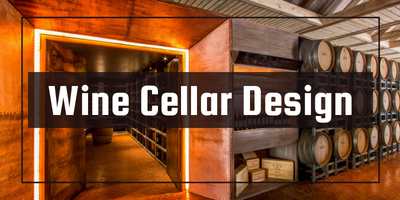
5 Signs Your Wine Cooling System Is About to Fail
Don’t wait for a costly surprise. Wine Guardian Dealer breaks down the top 5 signs your wine cooling system may be failing — and how to fix it before damage...
Jim Hopper
In Stock & Ready to Ship – Order Your Wine Cooling System Today!
Free Wine Cellar Expert Consultation | 📞 Call 1-800-260-1712
Start with a free expert consult—cooling system sizing, racking options, and no upsells.

Build your dream wine cellar—without costly mistakes or guesswork.
By Jim Hopper, Wine Cooling Expert
A DIY wine cellar is the perfect solution for the wine enthusiast looking to store and age their collection under optimal conditions. Whether you’re a casual collector or a serious connoisseur, a properly insulated and climate-controlled wine cellar ensures your bottles retain their quality and taste. 🍷
Active wine cellar cooling systems are the most appropriate for most people, as they provide consistent temperature and humidity control. Using a dedicated wine cellar cooling unit is crucial since standard air conditioners may not maintain the required humidity levels. ❄️
In this guide, we’ll explore the essentials of building your home wine cellar, from choosing the right location to selecting the best wine cellar cooling unit. Wine storage solutions are also an important consideration for maintaining the integrity of your collection. 📦
Once your wine cellar is complete, ongoing maintenance is crucial to protect your wine collection. 🛠️ For detailed step-by-step planning, layout help, and equipment tips, visit our full Wine Cellar Design and Installation: Build a Beautiful, Functional Wine Room That Lasts.

The ideal location for a wine cellar depends on several factors, including temperature stability, space availability, and accessibility. Wine cellars should be located in cool, dry areas of your home, with no natural light, no vibrations, and a controlled temperature. Common locations include:
After selecting the location, ensure to air out the cellar thoroughly to get rid of any unwanted odors, especially after applying water-based paints or stains. This will help create the perfect wine room
Assessing your basement space is a crucial step in creating a wine cellar. Before you begin, consider the size and layout of your basement, as well as any potential obstacles or challenges. Here are some key factors to consider:

Consider how many bottles you plan to store and the different bottle sizes and shapes you need to accommodate when evaluating the space needs for a custom wine cellar. A modular wine rack system allows for expansion while maximizing storage efficiency. Additionally, wine needs to be stored at an angle to prevent corks from drying out.
A DIY wine cellar can cost anywhere from a few hundred to several thousand dollars, depending on wine cellar construction materials, wine cellar insulation, and additional features. Plan your budget accordingly to balance quality and affordability.
When it comes to building a wine cellar, one of the most important decisions you’ll make is whether to tackle the project yourself or hire a professional. While DIY installation can be a cost-effective option, it requires a significant amount of time, effort, and expertise. On the other hand, professional installation ensures that your wine cellar is built to last, with proper insulation, ventilation, and temperature control.
If you decide to go the DIY route, make sure you have the necessary skills and knowledge to complete the project successfully. This includes understanding the principles of wine storage, selecting the right materials, and ensuring proper ventilation and insulation. However, if you’re not comfortable with DIY installation or don’t have the time and expertise, it’s highly recommended to hire a professional.
Professional installation offers several benefits, including:
Ultimately, the decision between DIY and professional installation depends on your budget, skills, and preferences. If you’re unsure, it’s always best to consult with a professional to determine the best course of action for your wine cellar project.

Preparing your space for a wine cellar involves several steps to ensure that your basement is ready for conversion. Here are some key steps to follow:
When preparing home wine cellars, consider both aesthetics and functionality. Personal taste in wall finishes, such as water-based paint, and proper ventilation are essential for creating an ideal space.
Preparing the basement for conversion involves several steps to ensure that the space is ready for your wine cellar. Here are some key steps to follow:
Furring and framing are essential steps in building a wine cellar, as they provide the structural foundation for your walls and ceiling. Furring involves installing strips of wood or foam to raise surfaces and create space for insulation, while framing involves constructing the skeleton of your wine cellar using lumber.
When furring and framing your walls and ceiling, keep the following tips in mind:
By following these tips, you can create a sturdy and well-insulated wine cellar that will protect your wine collection for years to come.

Proper wine cellar insulation is crucial for maintaining optimal wine cellar conditions and consistent temperatures. Use closed-cell foam insulation and install a vapor barrier to prevent excess moisture and mold growth.
Installing wine cellar doors is a crucial step in creating a functional and secure wine cellar, ensuring optimal wine cellar conditions. Here are some key factors to consider:
Once your walls and ceiling are furred and framed, it’s time to prime and paint them. This step is crucial in creating a durable and long-lasting finish that will withstand the humid environment of your wine cellar.
When priming and painting your walls, keep the following tips in mind:
By following these tips, you can create a beautiful and functional wine cellar that will showcase your wine collection in style.

Wine cellar humidity control is crucial as wine should be stored at 55°F – 58°F with 60-70% humidity to ensure it is ready for the perfect drink and proper aging. Fluctuations can impact taste and bottle longevity.
When selecting the best wine cellar cooling unit, it's important to consider the different wine cellar cooling systems available.
Proper wine cellar cooling unit installation is essential for efficient operation. Ensure optimal airflow, seal all openings, and follow manufacturer guidelines.
Complete wine cellar service ensures longevity. Once your wine cellar is complete, ongoing maintenance is crucial. Dust racks, clean cooling unit filters, and monitor wine cellar humidity control.
As your wine collection grows, consider modular wine racks or upgrading to a larger wine cellar cooling unit.
Proper wine storage is essential to preserving the quality and flavor of your wine collection. Here are some tips to keep in mind:
By following these tips, you can ensure that your wine collection is stored properly and will continue to age and improve over time.
Building a DIY wine cellar enhances your home while preserving your wine collection. Whether designing a small wine cellar or a basement wine cellar, proper planning, wine cellar insulation, and wine cellar cooling unit installation are key to long-term success.
A through-the-wall wine cooling unit is a self-contained system designed to maintain optimal wine cellar conditions. These units are perfect for DIY wine cellars, offering efficient temperature and humidity control without requiring extensive ductwork or split systems.
Selecting the right BTU rating ensures proper wine cellar cooling:
Look for quiet operation and energy-efficient wine cooling systems to keep energy costs low and maintain a peaceful wine room environment.
|
Model |
Capacity |
Noise Level |
Key Features |
|---|---|---|---|
|
Breezaire WKL 4000 wine cooling unit |
1,000 cu. ft. |
Low |
Digital thermostat, reliable performance |
|
WhisperKOOL SC Pro 4000 |
1,000 cu. ft. |
Medium |
Advanced humidity control, sleek design |
|
CellarPro 1800QT |
400 cu. ft. |
Ultra Quiet |
Energy-efficient, adjustable settings |
At Wine Guardian Dealer, we are committed to providing top-tier wine storage solutions that ensure your wine cellar maintains ideal conditions year-round. As an authorized Wine Guardian dealer, we offer expert guidance, premium-quality wine cellar cooling systems, and unmatched customer service. Whether you're looking for a through-the-wall wine cooling unit, a self-contained system, or an advanced ducted wine cellar cooling unit, we have the perfect solution for your needs.
Building a wine cellar is a rewarding investment for wine enthusiasts. Whether you go DIY or hire a pro, the key is ensuring proper insulation, cooling, and organization.
🔹 Looking for the best wine cooling system? Explore Wine Guardian Cooling Units Now!
🔹 Need expert guidance? Contact us for custom recommendations.
For a seamless buying experience and the best through-the-wall wine cooling unit, visit Wine Guardian Dealer today!
To build a functional wine cellar, you need proper insulation, a vapor barrier to control humidity, a dedicated wine cooling unit, durable wine racks, and moisture-resistant flooring and walls.
The best place for a wine cellar is a cool, dry location like a basement, away from natural light and vibrations that can affect wine aging.
The ideal temperature for wine storage is between 50–60°F (10–15°C), with humidity levels maintained between 50–70% to preserve cork integrity and prevent oxidation.
Yes, even small spaces like closets or under-stair areas can be converted into wine cellars using compact cooling units, space-saving racks, and custom shelving.
🛒Shop our most-loved Wine Guardian cooling systems today.
🛠️Protect your wine with the most trusted systems on the market.
❤️Tested, reviewed, and loved by serious collectors like you.